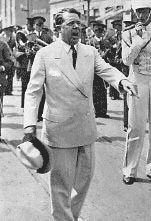|
LSU's First Football Game – I
Dr. Charles Coates, a young chemistry professor from Baltimore, was surprised that LSU had no football team when he arrived in Baton Rouge in 1893.
- Having played the game at Johns Hopkins, one of 89 colleges that fielded a team at that time, he set about organizing a squad with the assistance of professor H. A. Morgan, who had played rugby in Canada.
- They assembled a 27-man squad from the all-male student body of about 300 on the campus at what is now the State Capitol grounds.
Meanwhile, in New Orleans, T. L. Bayne, former star QB at Yale and captain of the Southern Athletic Club, had begun football at Tulane, where he was in law school.
- He elected himself head coach, obtained one of the few footballs to be found in Louisiana, and scheduled a game with his Southern Athletic Club.
- He also hired Crescent City Base Ball Park (across from Greenwood Cemetery), marked the field, put up goal posts, printed and sold tickets, created a yell, selected Tulane's colors (olive and blue), and refereed the contest, which SAC won 12-0 on Saturday afternoon, November 18, 1893.
Bayne had also scheduled a game with LSU at the park for the following Saturday, November 25.
- During the ensuing week, he shuttled between New Orleans and Baton Rouge helping Coates and Morgan prepare the LSU squad, not a single one of whom had ever played football before.
- Bayne also sold the tickets at 50 cents each.
The new team at State University (as the Baton Rouge school was routinely called at that time) worked hard to build their physical endurance.
- Players awakened at 6:30 and took a 30-minute run.
- After classes each afternoon, the aspiring gridders broke into two teams and played a practice game for one and a half hours.
- A report the week of the Tulane game stated that the team "can now play a complete game without showing much fatigue."
 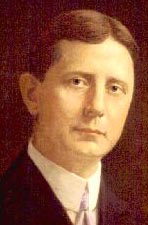
L: 1893 Football Game ( Army- Navy); R: Ruffin Pleasant, first LSU QB and governor of LA 1916-20 On the morning of the first game with Tulane on Saturday, November 25, 1893, Dr. Coates went with his captain and QB Ruffin Pleasant (future governor of LA) and several other players in search of ribbons for the contest.
- Coates found a Baton Rouge store with a large supply of Mardi Gras trimmings in purple and gold (two of the traditional Carnival colors, the other being green). So he purchased them for the fans who would make the trip by train to the Crescent City for the contest.
- However, this was not the origin of LSU's colors. An 1883 article reported that a group of ladies had presented the cadets with a flag that is "of handsome purple silk, fringed with gold ..." Also, the school's baseball team had worn purple and gold uniforms when it defeated Tulane 10-8 in the first athletic meeting of the two schools in the spring of 1893.
The round-trip fare on the "football special" was $1.50.
- If the Baton Rouge ticket agent sold 150 or more tickets, a special train would return from New Orleans that night.
- The response far exceeded the minimum, and the train "took 240 Baton Rougeans, many of them ladies, to witness the football match."
- The Daily Advocate also reported that "quite a number of our prominent citizens" had traveled to New Orleans a day earlier and would stay over for the "attractive and exciting event."
The players wore gray jerseys with purple trim as they arrived at Sportsman's Park along with 300 Old War Skule followers, including Colonel James W. Nicholson, the school president. (I spent a year in Nicholson Hall at LSU earning a Master's degree in math. The campus also includes Coates Hall and Pleasant Hall.)
- A crowd of between 1,500 and 2,000 gathered on the cold and cloudy day.
- Each side had a cheer devised for the occasion with plenty of Rah's in it in the style of the day.
Being the visiting team, LSU was allowed to select the referee.
- The purple and gold captain designated Coates.
- Tulane then chose its coach, T. L. Bayne, as the umpire.
- LSU won the first of two coin tosses and chose the goal to defend, while TU won the second toss and gained first possession.
The stage was set for the first football game in LSU history.
LSU's First Football Game – II
The rules in effect in 1893 called for eleven players on a side with a scrimmage line dividing the teams.
- Still much more like rugby than what we call "football" today, the game required the team on offense to begin a play by kicking the ball either forward or backward to the QB. He couldn't run with the pigskin but could pass it off.
- To maintain possession, the offensive team had to either gain five yards in three downs or not lose ten.
- No forward passing was allowed.
- A touchdown counted for 4 points, with 2 points for a goal after a TD, 4 for a FG, and 2 for a safety.
- Players wore an assortment of "football armor" such as "shin guards, rubber noses, head bands, ankle protectors, elbow and hip pads, and ear guards and mouth pieces."
The two 45-minute halves confirmed the superiority of the Tulane squad over the inexperienced LSU players.
- Starting the first possession of the game at midfield, Tulane scored on its second play when Coach T. L. Bayne's brother Hugh, a tackle, ran 30 yards from the flying wedge formation. As allowed by the rules of the day, Hugh was pushed and shoved across the goal line by his teammates. That gave Tulane a 4-0 lead.
- Hugh fell on the goal line and got some lime in his eye. A dash of water ended his intense pain and allowed him to continue in the game. A few minutes later, he scored another TD.
- Shortly afterwards, LSU's cause took a blow when QB Ruffin Pleasant hurt his hand and left the fray, Frederick Lyons taking his place.
- The home team added two points on a safety. Two more TDs made the score 18-0 at halftime as Tulane missed every one of its goals after touchdowns.
- Tulane tallied three more TDs and three conversions in the second half for a 34-0 victory. LSU did penetrate the opposition 10 at one point, but a fumble halted the drive.
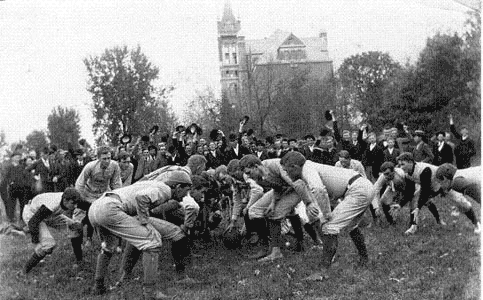
Football game 1893 or 1894
The Times Democrat summarized the game thusly:
At no time did the Baton Rouge boys have a ghost of a show for the game. ... The game was without the smallest exhibition of ill temper and the Baton Rouge boys took their defeat good-humoredly.
However, the editor of the Times didn't take the loss so good naturedly.
- He depicted State's team as country boys who had never seen a football game and whose military duties and schoolwork prevented them from practicing adequately.
- Tulane, on the other hand, deployed "fully developed men in the prime of life," many of them graduate students who had been "noted athletes" at other institutions.
- The editorial urged the cadets to schedule future games against schools whose teams consisted only of undergraduates. The paper did add, though, that, "We do not for an instant charge Tulane with unfairness, as our boys were aware of the conditions existing there before they consented to the game."
Thus were born LSU football, fans who travel with the team, and sour grapes after losses.
References: The Fighting Tigers II, LSU Football 1893-1980, by Peter Finney
The Louisiana Tigers: LSU Football, Dan Hardesty (1975)
Interesting Story: One-Game Sensation
This is one of many stories involving Huey Long, Governor of Louisiana from 1928-1932 and then U.S. Senator until his assassination in 1935.
- The "Kingfish" was a huge promoter of LSU and the football team's #1 fan.
- However, it wasn't in Long's nature just to cheer from the stands during games.
Before the 1931 season, Long received a newspaper clipping extolling a HB at a New Mexico junior college named Art Foley.
- Kingfish sent the the graduate manager of athletics, Thomas "Skipper" Heard, to find Foley and bring him to LSU.
- Heard found Art vacationing with his family in Mineral Wells TX. Finding that Foley liked golf, Heard bought some clubs and played several times with him.
- He followed the Foleys back to their home in Eufaula OK, where he played some more.
- When Heard phoned Huey and told him Art loved golf, the governor sent him new clubs. (Recruiting rules were much laxer then, not that Huey worried about rules.)
Foley promised to report to LSU in September where he would be eligible immediately since he had attended a junior college.
- However, when fall practice began, no phenom.
- So Heard returned to Oklahoma and brought Foley back. Long made sure he had the best accommodations.
- On the Saturday after Labor Day, as Coach Russ Cohen's Tigers prepared for their first scrimmage, a limousine drove onto the field.
- Out stepped Huey who opened the rear door for Foley, whom he delivered to Cohen.
- Then Kingfish left with only a wave to reporters.
Foley was listed as the starting LHB for the opener in Fort Worth against TCU.
- However, it was Cohen's habit, a la Knute Rockne, to start his "shock troops," the second stringers before putting in the starters.
- Foley is mentioned only for his Q1 punting in the writeups of the game.
Art not only played in the home opener the next week but captured the headlines.
- Spring Hill College from Mobile provided the opposition in the first night game in LSU history.
- The newcomer electrified the crowd of 5,000 that braved a heavy drizzle throughout the contest.
- Foley broke loose repeatedly and scored three TDs, including a 56y run from scrimmage and a 62y punt return, to spark a 35-0 romp.

LSU Stadium for First Night Game, 1931 Foley played in the next game, a 19-12 victory over South Carolina. However, Art did not do nearly as well as in his debut.
- He carried the ball eight times but netted only 4y, gaining 20 and losing 16.
- Reporters attributed his lackluster performance to the fact that the Gamecocks of the Southern Conference presented a more formidable opposition than Spring Hill.
- M. G. McCann of the Baton Rouge State Times Advocate wrote this the following Tuesday:
Foley is a good back. He looked poor against Carolina, but he learned a lesson. You've got to get up and go when you carry that ball in the Southern conference. Dancing back of the line while hunting for an opening is almost certain suicide in this league. ... The main thing this writer likes about Foley is that he tries for a touchdown instead of merely a gain every time he tucks the pigskin under his arm. ... This Foley has the stuff and he'll come through before the season is very much older. He's still underweight and can't be expected to flash his true form at this time. But he's got the right idea - a touchdown every time he runs.
Foley didn't play in the 31-0 romp over Mississippi State.
- One article mentioned a "preseason illness" and "much pulling of bad teeth."
- With no explanation from LSU, reporters assumed Art would return for the game at Arkansas.
- But on Wednesday, Cohen announced that Foley's season had ended.
- Diagnosing a lung ailment, a doctor advised the lad to give up football and live in a dry climate.
- Kingfish gave Art a new Ford sports car to drive to New Mexico, where Foley had attended junior college.
- Art died several years later.
Reference: The Fighting Tigers II, LSU Football 1893-1980, by Peter Finney
The Louisiana Tigers: LSU Football, Dan Hardesty (1975)
Did You Know? Tigers Invade Ebbets Field
On October 12, 1935, just six weeks after Huey Long's assassination, LSU played the Manhattan College Jaspers at Ebbets Field, home of baseball's Brooklyn Dodgers.
- The late Kingfish had planned another "economy" railroad trip for LSU students and a march down Broadway.
- Although that part was not to be, the events on the field would have put a big smile on Huey's face.
Bernie Moore had lost his debut as head coach 10-7 to Rice in Baton Rouge. However, his Tigers came from behind on the same field to down Texas 18-6 with 12 in Q4 to even their record heading to the Big Apple.
The Jaspers had amassed 116 points in their first three games, more than they had scored in nine games the previous season. Some observers Chick Meehan's aggregation the best in Manhattan history. However, their scoring spree would run into a brick wall against the Tigers.
Improving their execution of Moore's single-wing attack each week, the Tigers walloped Chick Meehan's Jaspers 32-0 before 20,000.
The New York Times story on the game started this way:
With one of the best conceived aerial attacks seen in these parts for a long time, a brilliant Louisiana State eleven completely smothered a hard-fighting Manhattan team that was able to cope with everything the foe from the bayous had except passes.
After a scoreless opening period, triple-threat TB Abe Mickal, one of the greatest players in LSU history and later a doctor and high school official in New Orleans, engineered the first TD when he tossed a "perfect pass" from the Manhattan 30 into the outstretched arms of FB Arthur "Slick" Morton, who took the ball on the 20 and dashed over for the score. The EP try failed.
Louisiana's second score came on the last play of the half on another pass from Mickal, this one for 15y to Jess Fatherree who received on the 5. "There was just time enough left for Mickal to try to convert the point." (That line in the Times article implies that a team scoring a TD with no time left in the half could not attempt the PAT.)
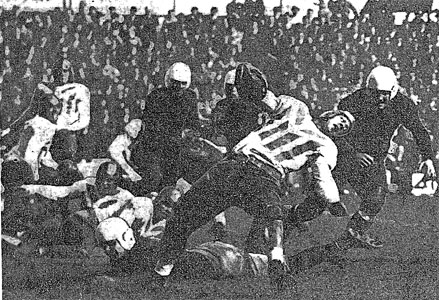
LSU's Rock Reed upended in opening period. (NY Times)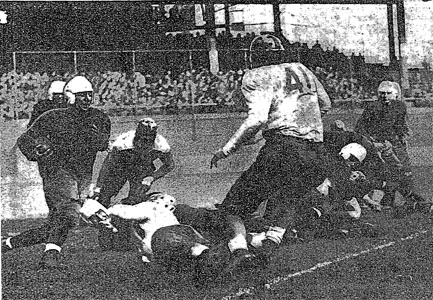
Manhattan QB Vic Fusia runs against Tigers in Q2. (NY Times)
LSU wasted little time in adding to its lead after the break. 6' 200 lb Bill Crass replace Mickal at TB and threw a 42y pass to Rock Reed, the latter making a "sensational run" after taking the short toss over RE. "It was a play the visitors reheared diligently while warming up." QB Vic Fusia ran Reed out of bounds on the 24. On the next play, Crass circled RE to the 5. The Jaspers held for two downs but then, from the 1, Crass tossed to a wide-open Fatherree in the flat, and he stepped over to make the score 19-0. |
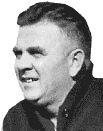 Coach Bernie Moore
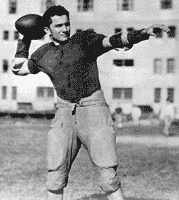
Abe Mickal
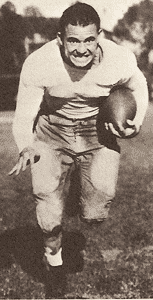
Jess Fatherree

Bill Crass
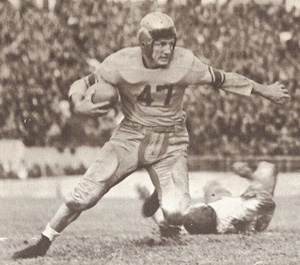
Charles "Pinky" Rohm
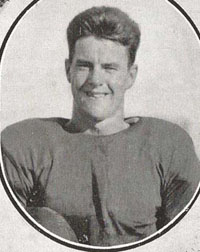 Jeff Barrett
|
The visitors drove again, attaining a first and goal on the 10. Key plays were Crass's 20y pass to E Jeff Barrett to midfield and Crass crashing up the middle for 27y. Crass went OT for 9, then Fatherree moved it to the 10. Manhattan then held for five downs, an offside giving the Tigers an extra play. The final thrust was stopped on the 1' line.
The fourth Tiger scoring march started with C/LB Roy Knight intercepting Fusia's pass at midfield. It ended with Minden's Pat Coffee hitting Charles "Pinky" Rohm with a 31y strike to the goal line, Pinky making a "brilliant catch, clutching the ball high in the air."
The final points came on Pinky's 53y run.
Rohm started on a long run around his own LE, running clear across the field. He seemed to be cornered, but pulled away from the grasping arms of Manhattan tacklers, darted down the side lines and then pivoted in and outran his pursuers. It was a brilliant bit of broken-field running, almost every man on the Jasper team having a chance to bring him down before he finally cut loose.
The final stats reflected the Bengals' dominance.
- LSU led in first downs 12-6.
- The Tigers outrushed the Jaspers 207-110.
- The passing yardage titled even more toward LSU, 193-16.
The teams combined for 25 punts in an era when coaches routinely called for 3rd, 2nd, or even 1st down boots. The Times writer praised the "brilliant kicking by the punters of both teams, Crass and Mickal for L.S.U. and Welch for Manhattan."
Moore's first Tiger team finished the regular season 9-1 and 5-0 in the SEC to capture the conference championship. TCU upset LSU in the Sugar Bowl, 3-2. Reference: The Fighting Tigers II, LSU Football 1893-1980, by Peter Finney
Dazzling Debut: Tommy Hodson
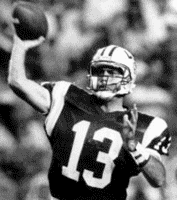
Tommy Hodson
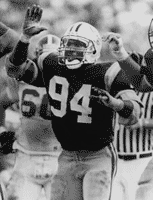
Michael Brooks
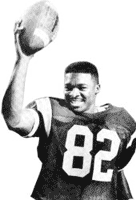
Wendell Davis
|
QB Tommy Hodson from Central Lafourche
HS in south Louisiana was the prized recruit of LSU's 1985 class.
- However, he suffered a frayed nerve in his passing
arm in the annual high school all-star game and red-shirted
his first year in Baton Rouge.
- He watched senior Jeff Wickersham lead the Tigers to a 9-2-1
record in Bill Arnparger's second year as head coach.
When Hodson finally made his debut in 1986, he was thrust into the starting job.
- He didn't get to warm up against
a "rent-a-win" team like North Texas or Rice.
Instead, his first opponent was Jackie Sherrill's Aggies on ESPN
on a Saturday night, September 13, 1986.
- Texas A&M was the defending Southwest Conference and
Cotton Bowl champions and were ranked in the Top Ten in the
pre-season polls. Fortunately, the game was in Tiger Stadium.
As expected, A&M controlled the ball early in building up a 14-7 lead.
- The Tiger TD came on a 3y pass from Hodson to RB Sammy Martin.
- Backup QB Mickey Guidry,
whom Arnsparger played for several series every
game, led a drive that made the score 14-14 at the half.
Calling
on his expertise from his days as Don Shula's D coordinator for the 1972 undefeated Dolphins, Arnsparger made adjustments while the bands entertained.
- After the Chinese Bandits held the Aggies to a FG after they recovered a fumble in Tiger territory early in the second half, the energized D held the
visitors scoreless the rest of the way.
- Hodson marched his offense down the field for the go-ahead TD on a
1y run by another super frosh, Harvey Williams,
who had chosen LSU over A&M.
- In Q4, Tommy threw
a 5y TD pass to WR Brian Kinchen for a
28-17 lead.
- Then LB Michael Brooks returned
the Tigers' fifth INT of the night 36y for the
icing on the cake: 35-17.
- For the evening, Hodson was 15 of 22 for 193 yards. His summer workout partner, WR Wendell
Davis, caught 10 for 132 yards.
After
four years of stardom, Hodson left LSU with numerous records.
- 438y in a game vs. Tennessee in 1989 (later broken by Rohan Davey)
- 49 consecutive passes without an interception (also vs. Tennessee)
- 4 TD passes in a game, which he accomplished twice (tying many
others), 2,655y passing in a season (1989 – since
broken by three others)
- 22 TDs in a season (1989, breaking
his own record from 1986 – another record since broken
by several others)
- 236.7 ypg for the 1989 season (also
broken by Davey and JaMarcus Russell).
Hodson is most famous, however,
for throwing the winning touchdown to RB Eddie Fuller in the last minute of the "Earthquake Game" against Auburn in 1988. |
Streak Buster: LSU vs Alabama 1993
Mired in another lackluster season with a 3-5 record, the Tigers traveled to Tuscaloosa to play the Crimson Tide in an 11 AM game televised by Jefferson-Pilot Communications. Just four weeks earlier, LSU suffered the worst defeat in its history, 58-3 to Florida. #5 Bama's only setback was a 17-17 tie with Tennesseethree weeks earlier that ended its 28-game winning streak. However, the Crimson still boasted a 31-game non-losing streak.
With the home team a 25-point favorite, the Mobile Register headline that Saturday morning proclaimed: TIDE COULD LOSE, PIGS MIGHT FLY. Columnist Jimmy Wigfield wrote: "[Gene] Stallings will be merciful to his old pal [Curly] Hallman. Alabama 30, LSU 7."
- After holding LSU to three-and-out, Bama went right down the field, but Michael Proctor's 46y field goal hit the right upright. A portent?
- With several Tide running backs out of action, the Tiger defense held the heavy favorite to a 0-0 halftime tie. The pigs were at least getting loose on the runway.
- On Bama's first third quarter possession, FS Anthony Marshall's interception put LSU in business at the Bama 38. Soon TB Jay Johnson plunged over from the two. LSU 7-0 with 10:41 left in the period.
- Stallings put Freddie Kitchens under center to spark the offense. But after a fake punt gained 43y, Kitchens threw a pick to Ivory Hilliard at the LSU 24. Hilliard's lateral to Tory James and an Alabama penalty on the runback put the ball at the Tide 37. It took only five plays for Robert Toomer to score from the two. Who would have believed it? LSU 14-0
- Flanker David Palmer now took over at quarterback for Bama running what would today be called the "Wildcat Formation." His 3y touchdown pass to FB Tarrant Lynch cut the Tiger lead in half going into the fourth quarter.
- Another interception, this one by Rodney Young of a Palmer pass, set up a 36y field goal by Andre Lefleur to make it 17-7 LSU with 4:22 left.
- The Tide roared back, scoring on a 22y pass from Palmer to SE Kevin Lee. When Palmer was stopped on the 2-point conversion, LSU led 17-13 with 2:41 left.
- Alabama touched the onside kick before it went 10y, and LSU ran out the clock.
The victory had extra dimensions for LSU Coach Curly Hallman. He grew up in Northport AL, just 1.6 miles north of Tuscaloosa. When he wasn't recruited by Bear Bryant, Hallman played defensive back at Texas A&M under Coach Gene Stallings.
LSU Athletic Director Joe Dean, who had stood by Hallman through three lean years, wiped away tears of joy on the LSU sideline as bedlam broke out all around him.
The next day's Baton Rouge Morning Advocate headline roared BELIEVE IT! "Pigs will fly." T-shirts were flying off the shelves.
|
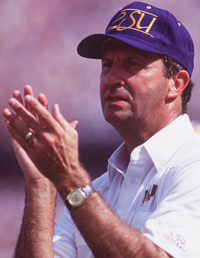
Curly Hallman
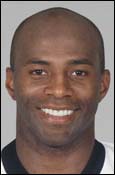
Tory James
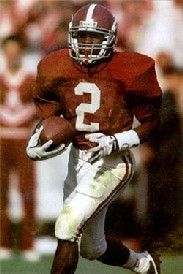
David Palmer
|
Dazzling Debut: Cecil Collins

Cecil Collins |
Tiger fans had been waiting for over a year to watch Cecil "The Diesel" Collins run in purple and gold.
- Collins had been Louisiana's 1995 Mr. Football after rushing for 7,833 yards and 99 TDs for his career with the Leesville Wampus Cats. However, he had been ruled academically ineligible for the 1996 season. All that season, insiders raved about how Cecil tore up the first string while running for the scout squad.
- Cecil started the 1997 season with a one-game suspension. The Tigers didn't need him in a 55-3 rout of Texas El Paso to start Jerry DiNardo's third season in Baton Rouge.
- Collins finally made his debut in Starkville on September 13. With star TB Kevin Faulk out of action with a leg injury, the Diesel filled the void with 172y on 22 carries in a 24-9 victory over the Mississippi State Bulldogs.
- Thus began the short but meteoric career of The Diesel at LSU.
|
Tiger First: Notre Dame Game: November 22, 1970
This was just a tremendous defensive performance by two of the finest college football teams in the country. I feel that LSU is probably the finest and quickest defensive club we have faced at Notre Dame Stadium since I have been here.
That was how Coach Ara Parseghian summarized the Fighting Irish's 3-0 squeaker over the Tigers in the first gridiron meeting between the two schools.
- Notre Dame entered the contest 8-0 and ranked #2.
- LSU, #7, had followed its opening upset at the hands of Texas A&M 20-18 with seven straight victories, including a win over Alabama in Birmingham. The Tigers boasted a 13-game streak of not allowing a rushing TD, tops in the nation.
- In that era when the NCAA limited telecasts of football games, the clash could be followed only on radio.
The home team excited the sellout crowd of 59,075 by mounting the game's first drive.
- After Ralph Stepaniak's INT return to midfield of a Buddy Lee pass, QB Joe Theisman whipped a 34y pass to his TE to the LSU 13.
- The threat ended when LB Lloyd Frye caused a fumble that Richard Picou recovered on the 4.
With its O line considerably outweighed by the ND front, the Tiger O struggled all afternoon.
- 6'5" 235-lb DE Walt Patulski threw LSU backs for an incredible eight losses totaling 42 yd.
- Lee and his backup, sophomore Burt Jones, completed only three passes each.
- K Mark Lumpkin missed a 49-yd FG in Q2 to end LSU's only scoring threat of the half.
Fortunately, Charlie McClendon's D was stifling the Irish's #1 ranked O.
- The #2 man in total O in the nation, Theisman had his worst game of the season, completing only 14-of-30 for 149 yd and one INT and gaining only 16 yd on 15 rushing attempts.
- Junior Tom Gatewood, the nation's second leading receiver, caught only four passes for 21 yd, chiefly due to the efforts of CB Tommy Casanova.
After the scoreless first half, Irish fans undoubtedly expected their heroes to make adjustments and dominate the second half, but that was not the case.
- After yielding only 29y on the ground in the first half, the Tiger D outdid itself in Q3, when the Irish O netted a grand total of nine yards!
- Art Cantrelle led the visitors' attack with 94 yd rushing on 23 attempts. In Q4, after Bill Norsworthy's INT, Lumpkin had a makeable 34-yd FG blocked by Bob Neibart.
Notre Dame finally drove far enough to kick the winning FG in Q4 after several breaks went in their favor.
- After a third down Irish pass from inside their 30 fell incomplete, a Big Ten official called a phantom pass interference penalty on LSU, which gave ND a chance to drive further out before punting. Jim Yoder's kick went out on the Tiger 1.
- After LSU gained only 6y, Wayne Dickinson's punt traveled only to the 42, from where Mike Crotty returned it to the 36.
- On the first play, the Tigers were called for another pass interference penalty, this one more plausible, to put the ball on the 17.
- On third down, Theismann threw for Gatewood in the EZ. Casanova got his hands on the ball but couldn't hold it.
- Senior K Scott Hempel then booted the winning 24-yd FG with only 2:54 left.
- The final stats showed that ND's O, which had been averaging 540 ypg, amassed only 227. The Irish D returned the favor, holding the Bengals to 165, their lowest total for the year as well.
The postgame comments, as you would expect, centered on the Tigers' great effort.
- "We came in just right," McClendon said. "I would not make one change in what we did. I hate to lose a game with such a defensive effort, but that was the most enormous football team I've ever seen. Our kids gave as good an effort as I can ask." The coach got a handshake from Louisiana Gov. John McKeithen, who visited the dressing room proclaiming, "We gave them all the football they wanted."
- With bowls permitted to invite teams following their contests of this date, the Irish, who had rescinded their 44-year policy of not accepting bowl bids the previous season, received bids from both the Orange and Cotton Bowls. Parseghian would eventually take the Cotton invite in order to play the highest ranked opponent, Texas. After defeating Tulane and Ole Miss to finish 9-2, LSU would take ND's place in the Orange Bowl opposite Nebraska.
In a 2012 interview, Theisman recalled: We had never played a football team that was as fast as LSU. They weren't big, but the speed they had on the defensive side of the ball made us know it was going to be a long afternoon, and we were lucky to get away with a 3-0 win.
|
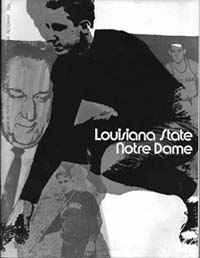
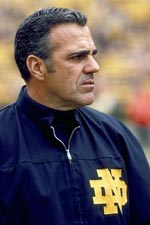
Ara Parseghian
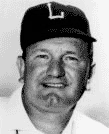 Charlie McClendon

Joe Theisman
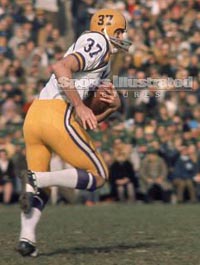
Tommy Casanova vs ND 1970
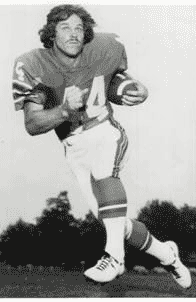
Art Cantrelle as a member of the Birmingham Vulcans of the WFL
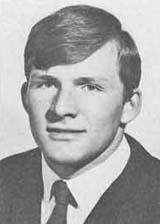
Walt Patulski
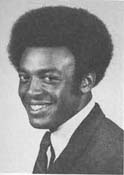
Tom Gatewood
|
Memorable Game: Alabama 1945

Coach Bernie Moore
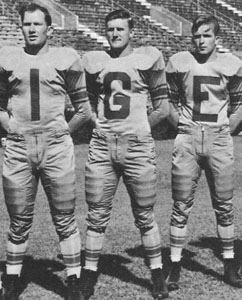
Y. A. Tittle, Ray Coates, Jim Cason
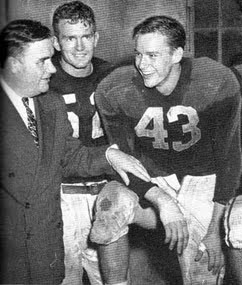
Frank Thomas, Harry Gilmer,
Lowell Tew
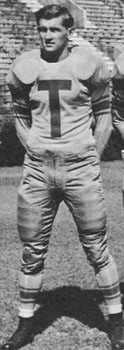
Dan Sandifer
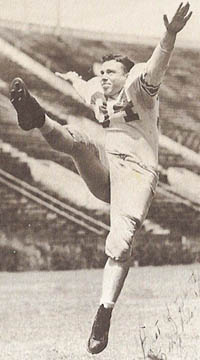
Red Knight |
When legendary Florida State Coach Bobby Bowden spoke at a Coaches Clinic in Baton Rouge in March 2010, he recalled his first visit to the LSU campus.
- Bobby, not quite 16, and his cousin traveled from Birmingham to watch their beloved Crimson Tide take on LSU.
- "I remember going down and taking pictures of the big, tall state capitol," Bowden recalled.
- Bobby graciously kept the recollections of the game to himself for reasons that will soon be clear.
With World War II just ended, LSU Coach Bernie Moore looked forward to the return of normalcy to his school and football team.
- Like most coaches, Bernie relied on a number of freshmen in 1944. The bad news was that the 2-5-1 record was LSU's worst since 1910. The good news was that the young players gained valuable experience. Chief among those freshmen was Y. A. Tittle, who showed great potential as a passer but was not that speedy a runner from the TB position in the single wing.
- So Moore decided to adopt the T formation. To that end, he and his staff visited Cornell to learn the basics of the T from Coach Ed McKeever, who had apprenticed under Frank Leahy at Boston College. (Four years later, McKeever would join LSU's staff.)
- Moore added an interesting twist to the LSU version of the T. Sophomore HB Ray Coates, not QB Tittle, would call the plays. Y. A. would take over only when Ray was not in the game.
LSU unveiled the new offense on September 29 against Rice in Tiger Stadium.
- The Associated Press story on the game started like this.
Warning signals flashed to the other Southeastern conference teams tonight as Louisiana State
University used an explosive, new
T-formation attack to score a 42 to 0 triumph over Rice Institute before 28,000 spectators.
- Another in the stable of talented Tiger backs, Jim Cason, set a school record by scoring three TDs in less than five minutes.
- Jim broke the scoring ice in Q1 when he scampered 29y "on a reverse which had some of the characteristics
of the hoary statue of liberty play."
- "On the second play after the
next kickoff, Slim Jim hauled in
a pass from Rice's Jess Mason and
barged all the way through 51
yards of tackier-infested territory."
- A few minutes later, Cason gathered in a pass from fellow Texan Tittle for another 29y score.
- The onslaught may not have served the Tigers well in preparing for their next opponent, Alabama. Frank Thomas's staff got a good look at LSU's new formation and could prepare for it.
Bama brought the Tigers and most of the 40,000 fans back to earth with a thud.
- The Tide had a pretty fair passer themselves in Harry Gilmer, who wasted little time in taking charge of the game. With less than five minutes gone, he threw the first of three TD passes. From the AP story:
He faded back, leaped high to
avoid the onrushing defenders, and
flipped a perfect strike into [Rebel] Steiner's arms on the 27. Steiner loped
over to complete a 50-yard play.
- Harry struck again less than two minutes later, although he had some luck on his side.
This time Gilmer's throw was a little wobbly. The ball
bounced out of Steiner's hands. In
grabbing for it, Louisiana's Dan Sandifer knocked it into the air again.
Lowell Tew pulled in the ball and
barged on over the goal. The play
was good for 50 yards.
- The Bama TB had one more scoring toss up his sleeve before halftime.
In the dying moments of the second period Gilmer started a 68-yard
scoring thrust by picking up five
around end. Then he found Steiner with a pass for 48 yards. Everybody
knew what was coming next, and
Gilmer didn't disappoint. He shot
a beauty to Steiner in the end zone.
LSU scored its only TD of the night in Q3.
- Sandifer somewhat made up for his earlier goof by intercepting Gilmer and running it out 28y.
- Red Knight sped 44y to the Alabama 28. Six plays later, Bill Montgomery stepped through T from the 6 into the EZ. Wayne Kingery placekicked the EP.
- The Crimson ground game accounted for the final TD in Q4 on a 28y march to make the final score 26-7.
The young Tigers could have packed it in, but Moore rallied them to a successful 7-2 season, including LSU's first ever victory over Georgia Tech. The Tide rolled to a 9-0 regular season and a 34-14 pasting of Southern Cal in the last Rose Bowl before the PCC-Big Ten pact.
|
LSU First: Game against UAB
The Alabama-Birmingham Blazers visited Tiger Stadium on September 23, 2000, in Nick Saban's fourth game as LSU coach.
- The Tigers had just lost their first game, at Auburn 34-17, after two home wins over Western Carolina and Houston.
- The coaching staff chose QB Josh Booty as the offensive player of the Auburn game despite the fact that Josh completed fewer than half his passes. However, he kept his poise under a furious pass rush and gave LSU a chance to win the game. 25-year-old Booty was in his second season at LSU after spending five years in pro baseball out of high school. After three games, Josh ranked second in the SEC and 11th nationally in passing efficiency with a 155.0 rating.
- Saban proclaimed it "hump week." We're looking for consistency and to make improvements. He wanted to see whether his new team would exhibit his philosophies - 60 minutes of intensity, anti-catastrophe syndrome, psychological disposition to succeed - to bounce back from the loss.
UAB received $410,000 to serve as LSU's sacrificial lamb for homecoming.
- Founded in 1969, UAB didn't play its first varsity football game until 1991, a Division III contest. Two years later, they moved to Division I-AA, and in 1996, joined Division I-A in Watson Brown's second year as head coach.
- After playing as an independent for three years, the Blazers became a member of C-USA in '99.
- UAB had played three road games against SEC squads and lost all of them: Auburn 29-0 and Vanderbilt 31-15 in '96, and Tennessee 37-13 in '98.
- Coming off a 5-6 season in '99, Brown looked forward to enjoying a productive offense with both QBs, five key RBs, and nine of 10 O linemen, returning. But an incredible rash of injuries felled 15 offensive players during fall practice, including the top RB and leading WR. It's been unbelievable, said Brown. We've been just devastated on offense.
- Dissatisfied with the play of fifth-year senior Daniel Dixon under C, Watson replaced him with redshirt Thomas Cox. In his only start, Cox had led an upset of East Carolina in '99, but that wasn't in front of 90,000 fans.
- Brown had even switched to the wishbone in a 23-20 loss at Kansas the week before. They run everything from A to Z, Saban said. They do all the stuff fairly well. They execute. And it fits together for them.
- LSU had not lost a homecoming game to a non-conference opponent since Florida State 38-14 in 1981. All signs pointed to the streak continuing against the 16-point underdog.
The Tigers played like they expected to just show up and win.
- RB LaBrandon Toefield plunged into the middle of the line, but DE Bryan Thomas stripped the ball, S Sentell Wilson falling on it at the LSU 33. Turnover #1.
- A pass interference call moved the ball to the 18. Three plays later, Rhett Gallego booted a 29y FG to put the visitors up 3-0.
- The Tigers creatively bungled their next three possession as it became clear that UAB could pressure the QB. On the first, Booty fired three incompletions in a row, one into the D-line, one into a huddle of UAB coaches, and the third way over the head of TE Robert Royal.
- The next drive ended on a pass that went off the hands of FB Tommy Banks into those of DB Adrian Singleton, who had vowed before the season that the secondary, after the graduation of three starters from '99, would not be the team's weak spot. Turnover #2
- With UAB unable to move either, the Tigers got the ball back at their 46 but bogged down because of penalties. Holding sabotaged a solid run by Domanick Davis. An ineligible receiver downfield erased a completion to WR Jerel Myers. Finally, an illegal block negated a 12y screen pass to Toefield.
- After receiving the 4th-and-19 punt, the Blazers drove 72y on nine plays, scoring on Dixon's 24y pass to WR Leron Little over CB Demetrius Hookfin. Brown inserted Dixon at QB after Cox went 0-for-5. Daniel ran for a first down on the march and completed all three of his passes.
- LSU mounted a comeback, reaching 3rd-and-1 at midfield, only to have Rod Taylor jar the ball loose from Davis so that teammate Otis Leverette could recover. At that moment, the Jumbotron replay showed an LSU fan in the stands giving a big thumbs down. Turnover #3
- The fan would have given another negative review to another play when TE Joe Domingeaux was wide open at the 50 but dropped the pass.
- The 10-0 halftime score didn't reflect how much the visitors pushed around the Tigers the first 30 minutes of action - er, inaction. LSU gained only 91y on 30 snaps against a team not noted for its D. Sam King of the Advocate called it perhaps the ugliest first half of play by an LSU team that this writer has seen in covering the Tigers for 35 seasons.
- Saban hurried to the locker room, skipping his interview for the LSU radio network.
The Tigers capitalized on a turnovers to tie the game.
- At halftime, the LSU staff made some changes in the O line, moving Louis Williams from LG to C in place of John Compton, who suffered a concussion in the first half, and inserting Rodney Reed at Williams' G position. The change helped because the Tigers steamrolled into Blazer territory on their first possession. However, a couple of incompletions forced a punt. But Percy Coleman juggled the fair catch, and LaVar Johnson recovered at the 19. But shortly afterwards, Booty threw an INT in the EZ. Turnover #4
- The Tigers had another chance to score, but Corbello was wide left on a 44y FG attempt.
- UAB consistently double-teamed WR Josh Reed, who had snared eight passes for 167y against Auburn. He didn't have a pass thrown to him until 12:23 remained in Q3 and didn't catch one until a 16-yarder with 8:48 remaining in the period.
- Two possessions later, the Blazers fumbled again, and this time LSU took advantage of the largesse. DT Byron Dawson stripped the ball from RB Carl Fair and MLB Treverance Faulk pounced on the pigskin at the UAB 35. However, an excessive celebration penalty on Faulk pushed the ball back to midfield. But LSU still cashed in. Combining a 23y reception with a couple of runs, Davis plunged over from inside the 1 to make it 10-7 with 3:25 left in Q3.
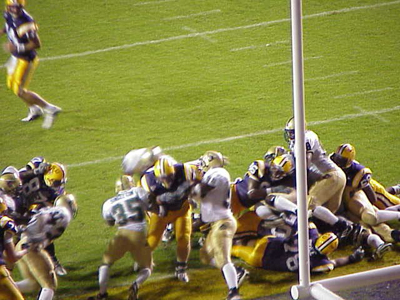
Domanick Davis scores LSU's TD.
- Early in Q4, Saban leaped in the air after LSU was penalized for delay of game. He yelled at Booty and pointed toward the play clock.
- FS Ryan Clark's INT at the UAB 45 put LSU in business again. The Tigers drove to the 18, where they bogged down. So Corbello propelled a 35y FG through the uprights to make it 10-all with 10:33 remaining in the contest.
After that, neither team was able to mount a threat.
- Booty had several misconnections with Myers that were signs of disaster to come. He and Jerel had words after a 3rd-down pass hit the ground even though Jerel was open. Then, on the second-to-last possession from his 15, Josh rolled out to escape a charging D lineman and threw downfield to Myers, who had two defenders on him on a sideline pattern. Fortunately, the ball wasn't intercepted.
- However, a few plays later, Booty made an ill-advised throw that provided Singleton's second INT. Turnover #5
- But the Tiger D continued to dominate the Blazers and nothing came of it.
When LSU received a punt on its 29 with less than a minute to play, the fans in the second largest crowd in Tiger Stadium (thanks to the newly-opened East upper deck) - at least those who hadn't left in disgust - got ready for OT.
- Even though only 33.4 seconds remained, LSU didn't plan to just run out the clock. As Saban explained afterwards: Dump the ball down to Domanick Davis, let him run for 10 or 15 yards. We had two timeouts. Maybe we can get it close enough that we need one play to kick a FG. We only had to go about 50 yards.
- But on first down, Booty audibled to a play that none of his teammates had heard of, dropped back, and launched a pass toward Myers, who never turned around because he didn't know the ball was coming. DB Chris Brown intercepted and returned 25y to the 17. Turnover #6
- After two runs positioned the ball in the middle of the field, Gallego booted an easy 32y FG as time expired to send the UAB back to Birmingham with a shocking 13-10 victory. The Blazers cavorted across the turf like so many opponents in recent year as they celebrated the biggest road victory in the 10-year history of the program.
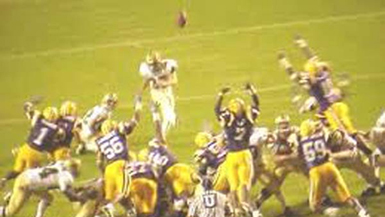 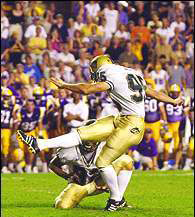
Gallego boots winning FG.
The statistics told a sad tale.
- LSU had more yards in penalties (113) than in rushing (107).
- The dropped passes equalled the turnovers - six. That was part of the reason Booty ended 15-of-38 for only 156y with four INTs.
- LSU held UAB to a measly 57y in total offense and three first downs in the second half while totaling 170 themselves.
- The Tigers lost their ninth straight game decided by less than a TD. Clearly Saban had his work cut out to change his players' mentality to finding a way to capture the close ones.
- LSU wasted an outstanding evening by kick returner Davis - 153y on two kickoff returns and six punt returns.
Postgame
- Saban: There's nobody who hates to lose more than me. If we're going to be a winning football team, we're going to have to start executing a whole lot better than we did tonight. ... If the players don't do what they're supposed to do out there, then we've got to do a better job of teaching and coaching them.
When we did get good field position, we found some way to shoot ourselves in the foot... There had to be 100y of plays thrown away in penalties. Most of the penalties were mental. Lack-of-discipline type penalties. ... We had the ball in the red zone three times, and we didn't get any points at all.
- Nick also lamented the dropped passes. That pass to Banks was a TD. And there's no tellnig how many yards Domingeaux could have gone had he caught the ball. That would have put us in position to score. ... We don't have a good enough team to be thinking we can go out and half-step and beat anybody.
On Booty's fateful pass: That last (INT) is not the kind of judgment you'd like to have in that situation. The play was supposed to be either a long pass to a receiver or a dump-off to a back. I don't know where that pass came from. There was no out route on that play. There was no way that ball should have been delivered there. Throw deep or throw the check route.
On why he didn't replace Booty: Rohan Davey is hurt; he didn't practice Tuesday. , our backup, Craig Nall, hasn't been practicing, and he wasn't ready, either.
- Booty: We didn't come prepared to play. We just didn't make plays all night, and I'll take some of the blame for that. Josh recalled a conversation with Saban shortly after Nick was hired as coach. He told me don't try to ad-lib. Don't try to make a play we didn't practice.
Concerning the final throw: I told Jerel he was uncovered, and he didn't pick it up. But he wasn't supposed to pick that up.
- LB Bradie James on Saban's insistence that they play hard for 60 minutes: Obviously playing hard is not going to get you a win. Playing hard will get you a chance to win. We have to execute. ... I thought we had them. If not, we were going to go into OT.
- Watson Brown: I don't think that anybody thinks that we go in and play for money. I give my kids a lot of credit to come in here and win this game. All week they had been reading the paper that this was just a "buy win," but we've been on the road playing people hard for four years now.
- DB Brown on his INT: It was very surprising. All I saw was the ball coming to me. I was looking at the receiver, and I never saw him look back for the ball.
The Birmingham News writer noted:
Maybe UAB coach Watson Brown should schedule more games against LSU. The last time a Brown-coached team played LSU it was 10 years ago when Brown was at Vanderbilt. The Commodores hosted LSU in Nashville and walked away with a 24-21 win. ... The Commodores went on to finish the season 1-10 ...
Reporters didn't see a bright future for LSU in 2000.
- John DeShazier wrote in the Times-Picayune that LSU likely will be hard-pressed to beat any of the remaining seven opponents on the schedule.
- King: No miracles were expected of Saban in his first year, only progress. Worse than a loss, even to UAB, is the lack of progress - in fact, just the opposite - shown in Tiger Stadium Saturday night.
Louisiana fans and the press hadn't gotten to know Nick Saban yet.
- The following week, he started Davey against Tennessee. The result was a shocking upset in Tiger Stadium for the second straight week, this time a 38-31 OT victory over the #11 Vols.
- The 2000 Tigers compiled a 7-4 record, good enough to earn an invitation to the Peach Bowl in Atlanta, where they beat Georgia Tech 28-14.
- 2001 brought an SEC championship and 2003, a BCS championship.
|

Nick Saban
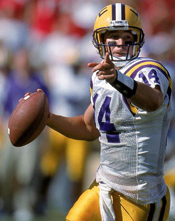
Josh Booty
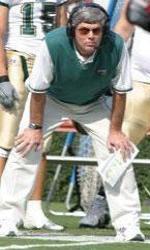
Watson Brown
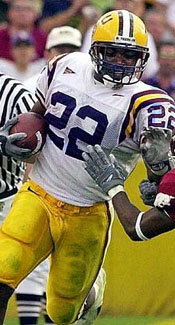
LaBrandon Toefield
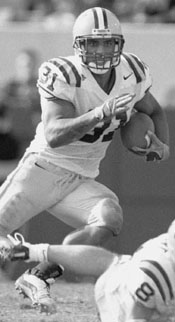
Domanick Davis
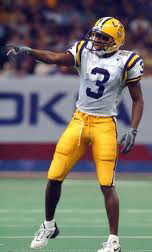
Jerel Myers
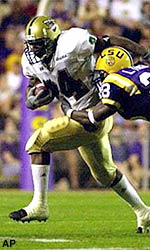
RB Jegil Dugger breaks away
from Lionel Thomas
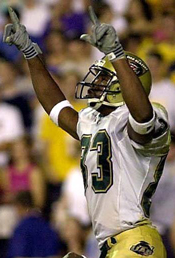
Leron Little celebrates TD catch
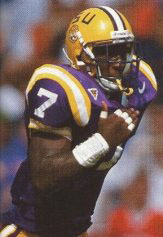
Trev Faulk
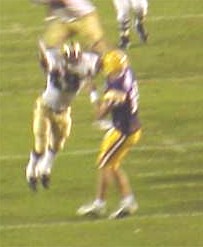
Booty throws INT off his back foot

Bradie James
Top of Page
|
|
CONTENTS
LSU First: Football Game – I
LSU First: Football Game – II
Interesting Story: One-Game Sensation
Did You Know? Tigers Invade Ebbets Field
Dazzling Debut: Tommy Hodson
Streak Buster: LSU vs Alabama 1993
Dazzling Debut: Cecil Collins
Tiger First: Notre Dame Game
Memorable Game: Alabama 1945
LSU First: Game against UAB
Tiger Den Archives – II
Tiger Den Archives – III
Tiger Den Archives – IV
Tiger Den Archives – V
Tiger Den Archives – VI
Tiger Den Archives – VII
Tiger Den Archives – VIII
Tiger Den Archives – IX
Tiger Den Archives – X
Tiger Den Archives – XI
Tiger Den Archives - XII
Football Magazine
Golden Rankings Home
Top of Page |



